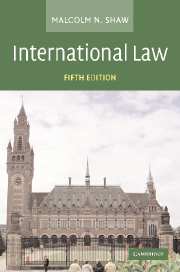Book contents
- Frontmatter
- Contents
- Preface
- Table of cases
- Table of treaties and selected other international instruments
- List of abbreviations
- 1 The nature and development of international law
- 2 International law today
- 3 Sources
- 4 International law and municipal law
- 5 The subjects of international law
- 6 The international protection of human rights
- 7 The regional protection of human rights
- 8 Recognition
- 9 Territory
- 10 Air law and space law
- 11 The law of the sea
- 12 Jurisdiction
- 13 Immunities from jurisdiction
- 14 State responsibility
- 15 International environmental law
- 16 The law of treaties
- 17 State succession
- 18 The settlement of disputes by peaceful means
- 19 Inter-state courts and tribunals
- 20 International law and the use of force by states
- 21 International humanitarian law
- 22 The United Nations
- 23 International institutions
- Some useful international law websites
- Index
- References
19 - Inter-state courts and tribunals
- Frontmatter
- Contents
- Preface
- Table of cases
- Table of treaties and selected other international instruments
- List of abbreviations
- 1 The nature and development of international law
- 2 International law today
- 3 Sources
- 4 International law and municipal law
- 5 The subjects of international law
- 6 The international protection of human rights
- 7 The regional protection of human rights
- 8 Recognition
- 9 Territory
- 10 Air law and space law
- 11 The law of the sea
- 12 Jurisdiction
- 13 Immunities from jurisdiction
- 14 State responsibility
- 15 International environmental law
- 16 The law of treaties
- 17 State succession
- 18 The settlement of disputes by peaceful means
- 19 Inter-state courts and tribunals
- 20 International law and the use of force by states
- 21 International humanitarian law
- 22 The United Nations
- 23 International institutions
- Some useful international law websites
- Index
- References
Summary
As has been seen, there is a considerable variety of means, mechanisms and institutions established to resolve disputes in the field of international law. However, a special place is accorded to the creation of judicial bodies. Such courts and tribunals may be purely inter-state or permit individuals to appear as applicants or respondents. This chapter will be concerned with the former. In resolving disputes, a variety of techniques is likely to be used and references to judicial bodies should be seen as part of a larger process of peaceful settlement. As Jennings has written, ‘the adjudicative process can serve, not only to resolve classical legal disputes, but it can also serve as an important tool of preventive diplomacy in more complex situations’.
Arbitration
In determining whether a body established by states to settle a dispute is of a judicial, administrative or political nature, the Tribunal in the Laguna del Desierto case emphasised that ‘the practice of international law is to look at the nature of the procedure followed by those states before the body in question’.
The procedure of arbitration grew to some extent out of the processes of diplomatic settlement and represented an advance towards a developed international legal system. In its modern form, it emerged with the Jay Treaty of 1794 between Britain and America, which provided for the establishment of mixed commissions to solve legal disputes between the parties.
- Type
- Chapter
- Information
- International Law , pp. 951 - 1012Publisher: Cambridge University PressPrint publication year: 2003



